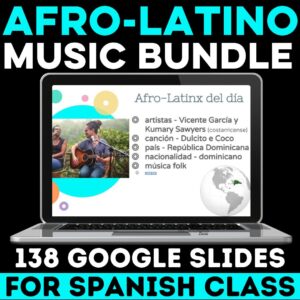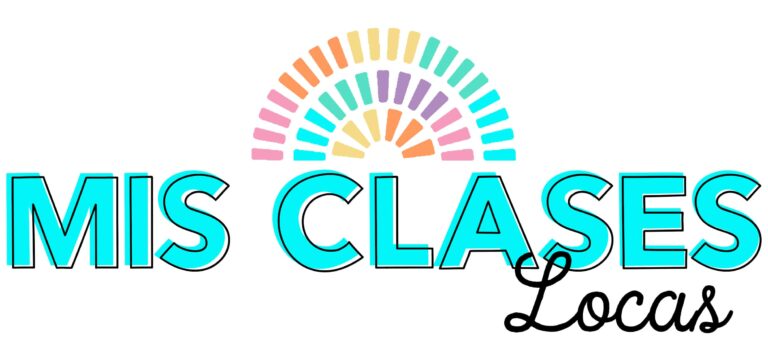Inside: Afro-Latino music resources for Spanish class. Diversify your Black History Month Spanish class playlist with Afro-Latinx música miércoles or mania musical music bracket in Spanish class. Afrolatino music in Spanish for a diverse playlist all year long.
Author: Allison Wienhold
Published: January 15, 2024 & most recently updated on December 17, 2024

Black History Month in Spanish class
As well as incorporating diverse voices all year long, February is the perfect time to specifically celebrate Afro-Latinxs during Black History Month. I know that BHM technically is celebrating African Americans, but as a Spanish teacher, I try to expose my students to a variety of ethnicities through the Spanish-speaking world. Black History Month in Spanish class has many ideas. Plus, I also have a new post about Movies for Black History Month in Spanish Class.
Music in Spanish class
If you have been reading Mis Clases Locas for a while you know that music in Spanish class has always been a passion of mine. It started with the weekly classroom routines of Música miércoles and Baile viernes back when this website started in 2014. I soon added yearly Spanish class music brackets with mania musical – March Music Madness & Hispanic Heritage Month Music Bracket. A few years ago, I started a line of resources that specifically highlighted Afro-Latinx musical artists in Spanish.
Spanish Class Music for Black History Month
My favorite way to introduce culture is always with music, so I created a slideshow to show and celebrate Afro-Latinx musical artists. The 1st version had classics like Celia Cruz and Susana Baca, mixed with current hitmakers like Choquibtown and Tego Calderon. Plus, over the years I created a 2nd version, a 3rd version, a version 4. Also, there is a Bundle option as well for the best deal.
This year I decided to completely revamp Afro-Latinx music slides. They are completely new for 2025. The Afro-Latinx Google Sides includes 22 new songs, plus the original 22 songs as a bonus.
Plus, you can now get Afro-Latinx music in Spanish from The Mis Clases Locas shop. Afro-Latino Music Bell Ringers 2025 & Afro-Latino Music BUNDLE
Afro-Latino Music Bell Ringers 2025

Afro-Latino Music BUNDLE


40 Afro-Latino artists & groups for Spanish class
- Alex Quin
- CIMAFUNK
- ChocQuibTown
- Celia Cruz
- Shel Dixon
- Valentin Puentes
- Herencia de Timbiquí
- Alejandra Robles
- NIA
- Roy Borland
- Omara Portuondo
- Ibrahim Ferrer
- Lido Pimienta
- Ibeyi
- Mala Rodriguez
- Vicente García
- Kumary Sawyers
- Alex Cuba
- Afro Dominicano
- Famous Oberogo
- YEИDRY
- Silvio Villalta Jr
- Laritza Bacallao
- El Individuo
- Ozuna
- Sech
- Kazzabe
- Lil Silvio & El Vega
- Pirulo y La Tribu
- La Ross Maria y Nino Freestyle
- Romeo Santos
- PALO!
- Systema Solar
- Leona de Etiopia
- Joan Soriano
- Descemer Bueno
- Kawe Calypso
- Grupo Bahía
- Don Omar
- Zion & Lennox
- Joysi Love

As always preview any song or video you use in your classroom. There are songs from each of these artists in my Afro-Latino Music BUNDLE. But, I would not use Every song from each of these artists in the classroom. If you want someone else to do the heavy lifting of previewing, get Afro-Latino Music Bell Ringers all ready to go.
But What Do I Do with the Afro-Latinx Music in Spanish Class?
One of the follow-up questions I often get about using music in Spanish class is “What to do with a song in Spanish class?” The answer to that question varies, but a common thread is how to discuss music in Spanish. This will help them learn the language better and give them insight into the culture and history of the countries where Spanish is spoken. Here are some specific ways to support students in how to talk about music in Spanish.
One Afro-Latinx Song Per Day of February

When I created the Afro-Latino Music Bell Ringers, my vision was to play one song per day for Black History Month. These could be used as a quick bell ringer or a brain break.
Just play the song as students enter. Introduce the artist, nationality, song, genre, and country in comprehensible Spanish. Then watch the video as a class. You could discuss how students feel about the song if they like it, or dig deeper with discussions if you have more time.
Since then, many creative Spanish teachers have shared the many ways that they use these Afrolatino music slides. So, here I will share many ideas of how to mix up using these music slides.
Talk About Afro-Latino Music in Spanish – Discuss the Songs

Once you have started dai;y Afro-Latinx music slides, it is helpful to teach students how to chat about a specific song. This might include slowly adding in vocabulary related to a song such as an artist, nationality, genre, beat, rhythm, etc. However, I know sometimes teachers want to spend more time with one song.
If you want ready-to-go activities to discuss any one song my chat about music Find Someone Who has two differentiated speaking versions. You have the option of 16 Basic Questions over 1 song (Spanish 1/2) or another page with 16 More Advanced Questions over 1 song (Spanish 3/4). Then there is a writing extension for each version as well. Learn more about Find Someone Who Interpersonal Speaking.
Also, my music question cards have these discuss one song questions in Spanish but in a different format. There are small cards to use with pairs, as well as large ones to post for walk and talk discussions around the room. See lots of ways to use question cards in this blog post.
Dig Deeper – Discuss the History & Culture Of Different Genres of Afro-Latinx music
For upper-level Spanish students who have been chatting about music for a while, you can go beyond just different genres of music in Spanish. You could also discuss the history and culture behind each style as well.
One of the key advantages of incorporating Afro-Latino music is the diversity it brings to the classroom. From salsa to cumbia, reggaeton to merengue, these genres carry the rhythms and traditions of both African and Latin American cultures.
For example, students might not know that the following Latin music genres have influences from African beats: bachata, cha-cha-cha, conga, mambo, tango, reggaeton, rumba, and more. By exposing students to diverse musical styles, we open the door to discussions about cultural richness, history, and the fusion of traditions.
Afro-Latinx Spanish Class Music Bracket

There are many different Spanish class brackets out there. In particular, you might know about my March Music Madness & Hispanic Heritage Month Music Brackets.
Over the years multiple teachers have let me know that they use my Afro-Latino Music as a music bracket. You can do a bracket with all 22 songs, or instead pick your favorite 16 songs, or 8 songs for a music bracket.
Instead of listening to one song per day, you listen to two and vote on who is the winner. Read Mania Musical Music Bracket FAQ for all of the music bracket details.
As a basic way to discuss songs and choose a winner, I have a Music Bracket Voting Form Free Printable. If you want to chat a bit more my music question cards have eight included questions specifically to compare two different songs. You could have these laminated and set out on desks for students to support students chatting with their neighbors about which song they like better and why.
Need more ideas about what to do with a song in Spanish class?
- Get lots more ideas here >> What to do with a song in Spanish class & the video below
More resources for Spanish Class this Time of Year
- Black History Month in Spanish class
- Movies for Black History Month in Spanish Class
- NEW Contemporary Afro-Latino Culture During Black History Month
- Carnaval in Spanish Class
- Valentine’s Day blog post – tons of ideas

Plus, if you want bonus Spanish class Music Slides – sign up below
Recap with resources to save you time!
Afro-Latino Music Bell Ringers 2025 & Afro-Latino Music BUNDLE
Incorporating Afro-Latino music into your Spanish classroom can be a transformative experience for both you and your students. By embracing the diverse artists and rhythms, you create an immersive and engaging learning environment. It goes beyond language acquisition to celebrate the diverse cultures that contribute to the Spanish-speaking world. Let the Afro-Latinx music become a bridge that connects language, culture, and the joy of learning.





